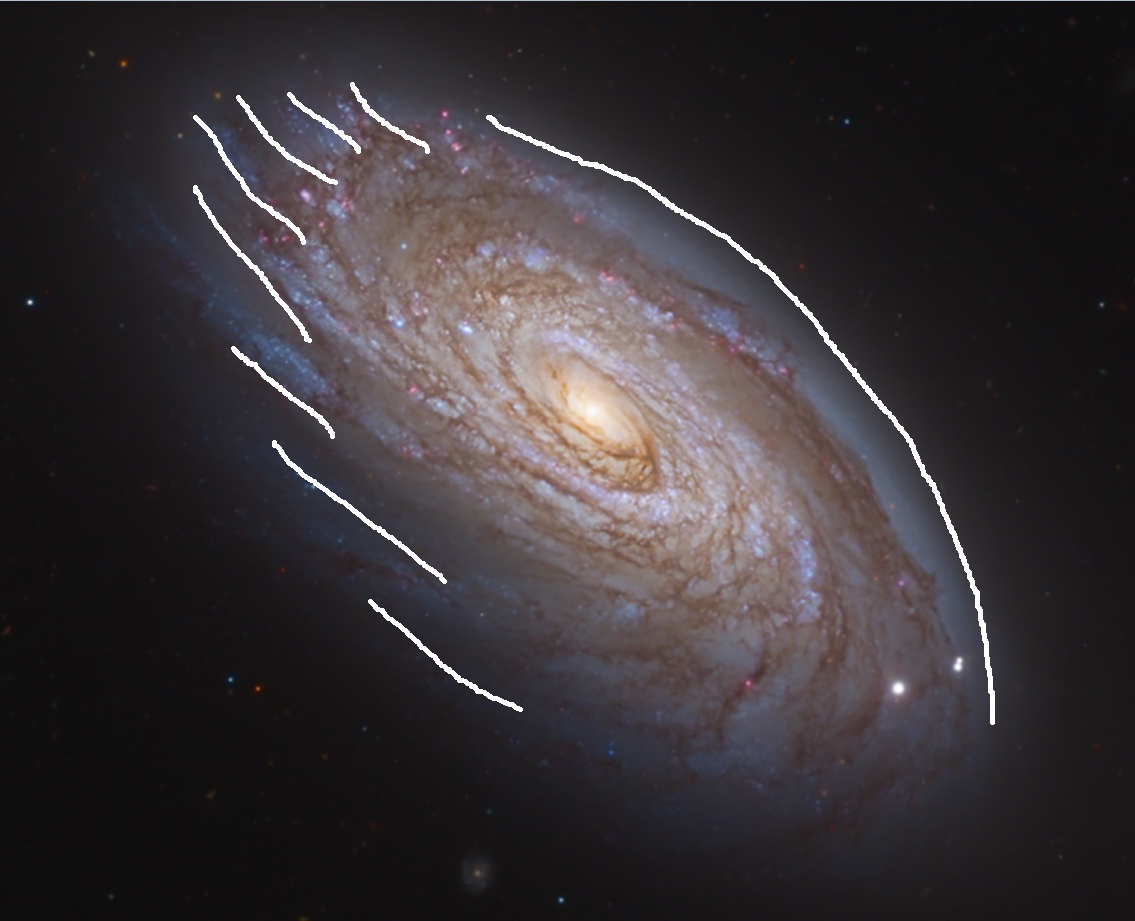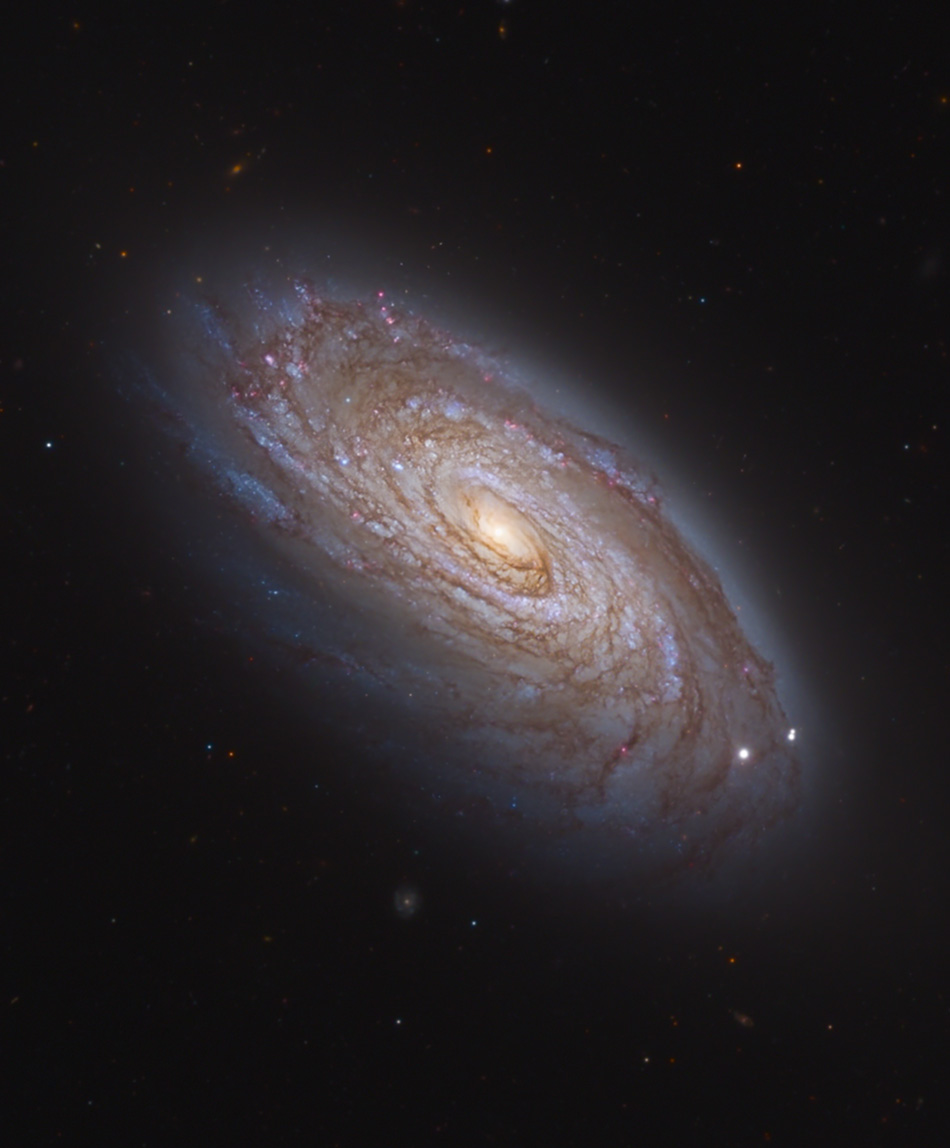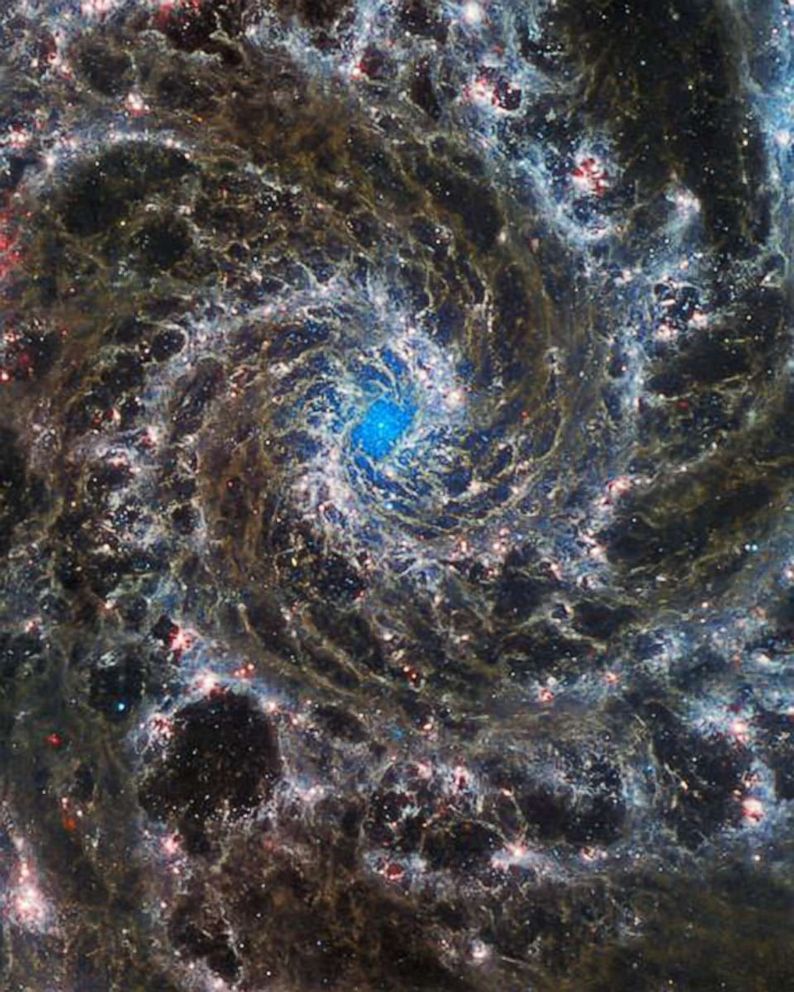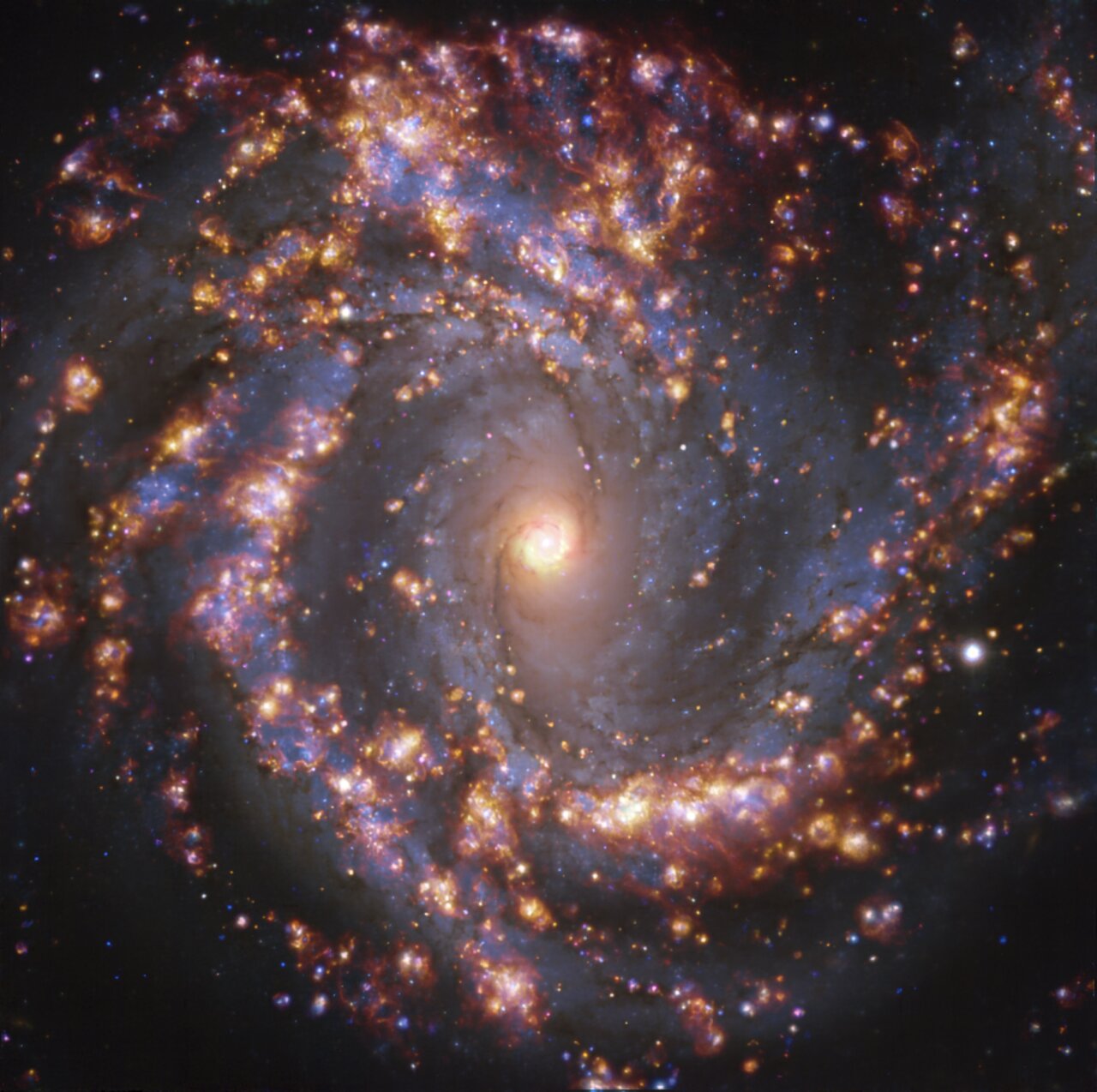Page 1 of 1
APOD: Messier 88 (2022 Dec 28)
Posted: Wed Dec 28, 2022 5:05 am
by APOD Robot
 Messier 88
Explanation: Charles Messier
Messier 88
Explanation: Charles Messier described the 88th entry in his 18th century catalog of
Nebulae and Star Clusters as a spiral nebula without stars. Of course the
gorgeous M88 is now
understood to be a galaxy full of stars, gas, and dust, not unlike our own Milky Way. In fact, M88 is one of the brightest galaxies in the
Virgo Galaxy Cluster some 50 million light-years
away. M88's beautiful spiral arms are easy to trace in this
sharp cosmic portait. The arms are lined with young blue
star clusters, pink
star-forming regions, and obscuring
dust lanes extending from a yellowish core dominated by an older population of stars. Spiral galaxy M88 spans over 100,000 light-years.
Re: APOD: Messier 88 (2022 Dec 28)
Posted: Wed Dec 28, 2022 7:26 am
by Ann
One side of M88 has been truncated by ram pressure.
I used to find M88 a pretty boring galaxy. I mean, just look at it. Its colors are unexciting, its center is small, its arms are unspectacular. What's to like about it?
But look again. One side of it is suspiciously smooth, and the opposite side is more windblown. And this is the key to what has happened to M88.
M88 probably used to look something like NGC 1232:
NGC 1232. Credit: Josef Pöpsel, Capella Observatory.
In other words, M88 used to be a lot more wild and crazy, with flamboyant arms and a lot of star formation. Ah, but then the Virgo Cluster happened to it!
Large galaxy clusters kill spiral galaxies by driving their gas out of them. These clusters are filled with a thin but super-hot gas and all sorts of tidal forces, which combine to drive the gas out of spiral galaxies.
Large Virgo spiral M90. Its gas is being driven out of it by tidal forces
and ram pressure of the Virgo Cluster. Image: A. Boselli et al.
Eventually, spiral galaxies in large galaxy clusters end up looking like NGC 4921:
Or rather, they end up looking like NGC 936.
Some galaxies are lucky. Sparkling, flamboyantly star forming M61 sits on the very southern outskirts of the Virgo Cluster, unaffected by the vicious conditions further in. And small elegant M74 is not a member of a galaxy cluster at all.
Ann
Re: APOD: Messier 88 (2022 Dec 28)
Posted: Wed Dec 28, 2022 10:44 am
by sc02492
Ann, your explanation should have been part of the APOD caption in my opinion- a missed educational opportunity for the APOD viewership. The ram pressure that smooths out the leading edge of M88 (the long, continuous white line on the right side of your annotated image) has been recognized for over a decade now (see this video from DeepSkyVideos
https://www.youtube.com/watch?v=THUti-X77sU), and it's one of the most interesting aspects of M88. In fact, the leading edge of the galaxy (the edge facing into the ram pressure) is compressed and as a result has more star formation compared to the trailing edge. This can be easily appreciated in the image by the presence of more HII regions in the smooth edge (which is also brighter because it is more dense) compared to the trailing edge. I would like to nominate you as a writer for APOD captions

.
Steve
Steve Cannistra
www.starrywonders.com
Re: APOD: Messier 88 (2022 Dec 28)
Posted: Wed Dec 28, 2022 12:28 pm
by orin stepanek
Windblown M88; Where does the gas go? Would this strip
any planets of their atmospheres? More ?'s more to know?
Mainly; it is a beautiful planet anyway!!!


Re: APOD: Messier 88 (2022 Dec 28)
Posted: Wed Dec 28, 2022 12:30 pm
by Ann
sc02492 wrote: ↑Wed Dec 28, 2022 10:44 am
Ann, you did here what should have been done for the APOD caption and for the original image presented on the Mt. Lemmon website in my opinion. Unfortunately, what we see these days are technically pretty pictures that do not fully describe (or describe at all!) the underlying processes occurring in the image. A missed educational opportunity for the APOD viewership. The ram pressure that smooths out the leading edge of M88 (the long, continuous white line on the right side of your annotated image) has been recognized for over a decade now (see this video from DeepSkyVideos
https://www.youtube.com/watch?v=THUti-X77sU), and it's one of the most interesting aspects of M88. In fact, the leading edge of the galaxy (the edge facing into the ram pressure) is compressed and as a result has more star formation compared to the trailing edge. This can be easily appreciated in the image by the presence of more HII regions in the smooth edge (which is also brighter because it is more dense) compared to the trailing edge. I would like to nominate you as a writer for APOD captions

.
Steve
Steve Cannistra
www.starrywonders.com
Thanks a billion, Steve!


But I couldn't even consider taking on such a daily chore. I want to thank the editors of the Astronomy Picture of the Day for the relentless hard work they have taken on to give us our daily fix of APOD!
Thank you!
Ann
Re: APOD: Messier 88 (2022 Dec 28)
Posted: Wed Dec 28, 2022 4:52 pm
by Lasse H
Can anything interesting be said about the white stars in the lower right? They are just a couple of stars in our galaxy, I guess. But one of them is double.
Re: APOD: Messier 88 (2022 Dec 28)
Posted: Wed Dec 28, 2022 5:08 pm
by VictorBorun
Ann wrote: ↑Wed Dec 28, 2022 7:26 am

One side of M88 has been truncated by ram pressure.
I used to find M88 a pretty boring galaxy. I mean, just look at it. Its colors are unexciting, its center is small, its arms are unspectacular. What's to like about it?
But look again. One side of it is suspiciously smooth, and the opposite side is more windblown. And this is the key to what has happened to M88.
Ann
Besides the extended spurs at top left, the disk is asymmetric in the way that it's thicker at its edge and dances when you rotate the image by 180°:
Offtopic. Extended claws along with hair-raising is how a rampant red panda is standing its ground

...
Re: APOD: Messier 88 (2022 Dec 28)
Posted: Wed Dec 28, 2022 7:23 pm
by jisles
Messier didn't describe the 88th entry in his 18th century catalog of Nebulae and Star Clusters as a SPIRAL nebula, as stated in the caption to today's APOD. You can read his original description here:
http://www.messier.seds.org/Pics/Mcat/mp262-263.jpg. Translated, it reads "Nebula without star, in the Virgin, between two small stars and a star of sixth magnitude, which appear at the same time as the nebula in the field of the telescope. Its light is one of the faintest and resembles that reported in the Virgin, No 58".
The first recognition of a spiral nebula was of course by William Parsons, Third Earl of Rosse, in 1845.
John
Re: APOD: Messier 88 (2022 Dec 28)
Posted: Wed Dec 28, 2022 7:38 pm
by Cousin Ricky
Messier never used the word “spiral”; his exact words were “Nébuleuse sans étoile.” Spiral structures were unknown until William Parsons discovered the spiral nature of M51, 61 years after Messier’s description was published.
Re: APOD: Messier 88 (2022 Dec 28)
Posted: Wed Dec 28, 2022 10:07 pm
by johnnydeep
Ann's explanatory post explains why galaxies are a lot like people, who are also at risk of losing their interesting qualities and uniqueness whenever they join a large group.
Also, very cute "rampant red pandas" Victor!
 Messier 88
Messier 88





